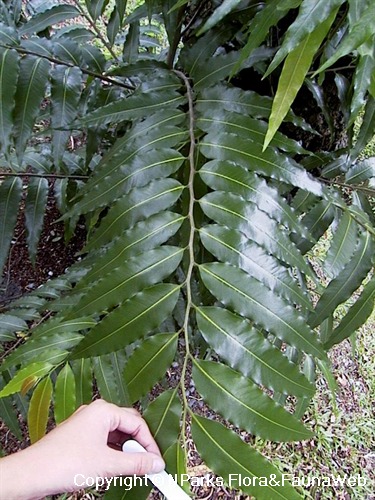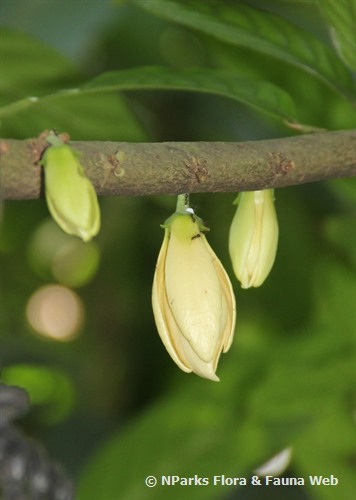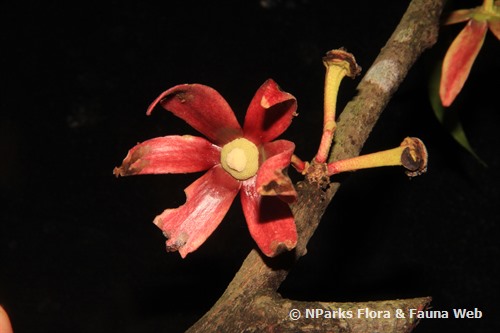
Back
Monoon longifolium (Sonn.) B. Xue & R.M.K. Saunders
| Family Name: | Annonaceae |
| Synonyms: | Uvaria longifolia, Polyalthia longifolia (Sonn.) Thwaites |
| Common Name: | Indian Mast Tree, Mast Tree, Sorrowless Tree, False Ashok Tree, Cemetery Tree, Asoka Tree, 长叶暗罗 |
Name
Classifications and Characteristics
| Plant Division | Angiosperms (Flowering Seed Plants) (Dicotyledon) |
|---|---|
| Plant Growth Form | Tree (Medium (16m-30m)) |
| Lifespan (in Singapore) | Perennial |
| Mode of Nutrition | Autotrophic |
Biogeography
| Native Distribution | South India, Sri Lanka |
|---|
Description and Ethnobotany
| Growth Form | Small to medium-sized, evergreen tree with narrow, columnar crown and weeping branches. It typically grows up to 8 - 12 m in cultivation, but can reach 20 m in the wild. |
|---|---|
| Trunk | Straight trunk has smooth, greyish brown bark. |
| Foliage | Smooth, glossy leaves are lanceolate with distinctly wavy leaf margins (11 - 31 cm long, 2.5 - 8 cm wide). Leaf tip is long and thin, while leaf base may be wedge-shaped or rounded. New foliage is yellowish to light brown, while mature foliage is dark green. Leaf arrangement is alternate with branches having one leaf per node. |
| Flowers | Pale green to greenish yellow flowers are star-shaped with 6 thin, linear petals. |
| Fruit | Smooth, ovoid to ellipsoid fruits (2 - 2.5 cm long, 1.5 cm wide) have fleshy pulp and occur in clusters of 20. Yellowish green, immature fruits ripen to become purplish black. Each fruit contains a single, large seed that is light brown and ovoid to ellipsoid with a curved, longitudinal groove along the surface (2 cm long, 1.4 cm wide). |
| Associated Fauna | The fruits are consumed by bats and birds. It is a favourite food for Koels, birds that belong to the Cuckoo family. |
| Cultivation | This species should be planted in fertile, well-drained soil in a sunny location. Individuals should be spaced 1.2 - 1.8 m apart. It is drought tolerant. Propagate by seed, stem cuttings or air layering. For seed propagation, allow fruits to become overripe before harvesting and remove the fleshy pulp from seeds before storing. |
| Etymology | The genus "Polyalthia" is derived from the Greek words for many ("poly") and healing properties ("althia"), referring to the flowers which were thought to have medicinal properties. The species epithet "longifolia" means "long leaves" in Latin ("longus" and "folium", respectively). |
Landscaping Features
| Desirable Plant Features | Ornamental Form |
|---|---|
| Landscape Uses | Suitable for Roadsides, Hedge / Screening, Focal Plant |
Fauna, Pollination and Dispersal
| Fauna Pollination Dispersal Associated Fauna | Butterfly Host Plant, Bird-Attracting |
|---|
Plant Care and Propagation
| Light Preference | Full Sun |
|---|---|
| Water Preference | Moderate Water |
| Plant Growth Rate | Moderate |
| Propagation Method | Seed, Stem Cutting |
Foliar
| Foliage Retention | Evergreen |
|---|---|
| Mature Foliage Colour(s) | Green |
| Mature Foliage Texture(s) | Smooth |
| Prominent Young Flush Colour(s) | Red |
| Foliar Venation | Pinnate / Net |
| Leaf Area Index (LAI) for Green Plot Ratio | 3.0 (Tree - Intermediate Canopy) |
Floral (Angiosperm)
| Flower Colour(s) | Green - Light Green |
|---|
Fruit, Seed and Spore
| Mature Fruit Colour(s) | Black, Purple |
|---|
References
| References | Xue, B., Su, Y.C.F., Thomas, D. C & Saunders, R.M.K. 2012. Pruning the polyphyletic genus Polyalthia (Annonaceae) and resurrecting the genus Monoon. Taxon. 61. 5. 1021-1039 |
|---|
Image Repository
Others
| Master ID | 1786 |
|---|---|
| Species ID | 3079 |
| Flora Disclaimer | The information in this website has been compiled from reliable sources, such as reference works on medicinal plants. It is not a substitute for medical advice or treatment and NParks does not purport to provide any medical advice. Readers should always consult his/her physician before using or consuming a plant for medicinal purposes. |



